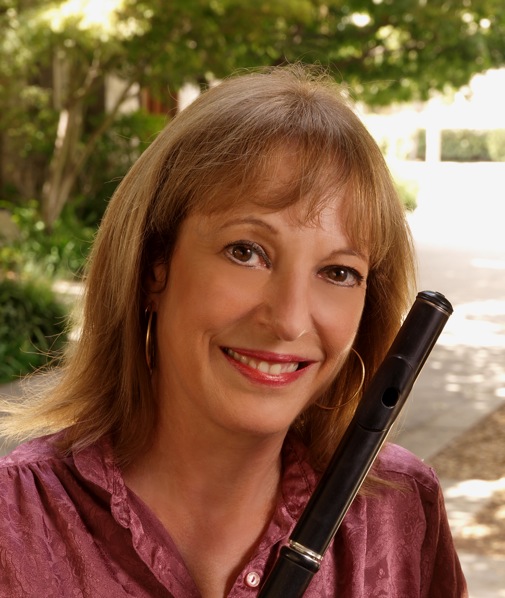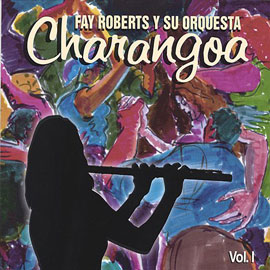SPOTLIGHT ON FAY ROBERTS
Flute Sounds – Summer 2002
By Yamaha®
 One of Yamaha’s new 800 series wood flutes has found a new home. Fay Roberts is a performer and recording artist from California who plays in a wide array of musical settings, but specializes in a type of music known as charanga. She was introduced to the grenadilla flute last December andimmediately fell in love. “I used to play a 10k gold from another brand, but since I began playing the Yamaha wood flute I’ve hardly even touched my other horn. I use the Yamaha for all of my practicing, playing and teaching.”
One of Yamaha’s new 800 series wood flutes has found a new home. Fay Roberts is a performer and recording artist from California who plays in a wide array of musical settings, but specializes in a type of music known as charanga. She was introduced to the grenadilla flute last December andimmediately fell in love. “I used to play a 10k gold from another brand, but since I began playing the Yamaha wood flute I’ve hardly even touched my other horn. I use the Yamaha for all of my practicing, playing and teaching.”
In discussing her music, Fay is careful to point out that charanga is a type of Cuban music similar to salsa and jazz, but with some distinct differences. For example, it is harmonically less complex than jazz, but rhythmically more complex. Also, instead of the horn section traditionally found in salsa bands, charanga bands contain a string section. Fay’s band, Charangoa, consists of two violins, a Latin rhythm section, three singers, and of course, a flute. In fact, charanga music features the flute in both melody and extended improvisation, making it the perfect vehicle for flute players. When asked how the wood flute fits in the charanga style, Roberts responded, “Charanga music demands a lot of playing in the third and fourth octaves in order to cut over the top of the rhythm section and the new Yamaha flute projects and plays excellent in that range. In fact, it has a mellower sound, especially in the fourth octave, and is much more pleasing to the ear than any metal flute that I have ever played.”
In 1996, Roberts took a trip to Cuba to experience charanga music in its native setting. She became very close with flutist Richard Egues, performer in the Orquesta Aragon and composer of El Bodeguero, the most famous cha-cha-cha to come out of Cuba. While she was visiting, she purchased some charts and arrangements to take back home to L.A. and start a band. At the end of the year, she made another trip to Cuba to study with Egues. She spent three rigorous weeks mastering the nuances of charanga under his tutelage, and he sent her back to the United States on a mission to keep charanga music alive. The rest, as they say, is history.
As for the versatility of the wood flutes, Fay points out that the new Yamaha can go places where traditional wood flutes would not dare tread. “I can use this flute in virtually any setting. Some players are hesitant to bring a wood flute into a concert hall, but I have no reservations when it comes to the Yamaha. I can some times sense the eyebrows raising when I walk into a classical music rehearsal with a wood flute, but! just tell people, ‘You’re lucky I showed up with this flute,’ and as soon as they hear it they agree! I also play in a bluegrass band and a flute and guitar duo, and the flute blends wonderfully.” Roberts will also be the first to mention that, compared to traditional wood flutes, these new flutes are in a league of their own. “This Yamaha has much better dynamic range, better intonation, and ahead- joint that is far superior to any of my wood flutes. I picked this flute up and automatically played better. Also, the lip plate on the Yamaha makes the transition from metal to wood much easier.”
 It is very clear that Fay Roberts possesses a sincere enthusiasm for the newest member of the Yamaha 800 series but she is also a testament to their durability. She performs on the wood flute with Charangoa at least two or three nights a week at various clubs in L.A., not to mention all of her rehearsals and other playing obligations. In addition to all the positive comments Fay has about the new Yamaha wood flutes, she best summed them up with three little words: “I love them!”
It is very clear that Fay Roberts possesses a sincere enthusiasm for the newest member of the Yamaha 800 series but she is also a testament to their durability. She performs on the wood flute with Charangoa at least two or three nights a week at various clubs in L.A., not to mention all of her rehearsals and other playing obligations. In addition to all the positive comments Fay has about the new Yamaha wood flutes, she best summed them up with three little words: “I love them!”


 One of Yamaha’s new 800 series wood flutes has found a new home. Fay Roberts is a performer and recording artist from California who plays in a wide array of musical settings, but specializes in a type of music known as charanga. She was introduced to the grenadilla flute last December andimmediately fell in love. “I used to play a 10k gold from another brand, but since I began playing the Yamaha wood flute I’ve hardly even touched my other horn. I use the Yamaha for all of my practicing, playing and teaching.”
One of Yamaha’s new 800 series wood flutes has found a new home. Fay Roberts is a performer and recording artist from California who plays in a wide array of musical settings, but specializes in a type of music known as charanga. She was introduced to the grenadilla flute last December andimmediately fell in love. “I used to play a 10k gold from another brand, but since I began playing the Yamaha wood flute I’ve hardly even touched my other horn. I use the Yamaha for all of my practicing, playing and teaching.” It is very clear that Fay Roberts possesses a sincere enthusiasm for the newest member of the Yamaha 800 series but she is also a testament to their durability. She performs on the wood flute with Charangoa at least two or three nights a week at various clubs in L.A., not to mention all of her rehearsals and other playing obligations. In addition to all the positive comments Fay has about the new Yamaha wood flutes, she best summed them up with three little words: “I love them!”
It is very clear that Fay Roberts possesses a sincere enthusiasm for the newest member of the Yamaha 800 series but she is also a testament to their durability. She performs on the wood flute with Charangoa at least two or three nights a week at various clubs in L.A., not to mention all of her rehearsals and other playing obligations. In addition to all the positive comments Fay has about the new Yamaha wood flutes, she best summed them up with three little words: “I love them!”
